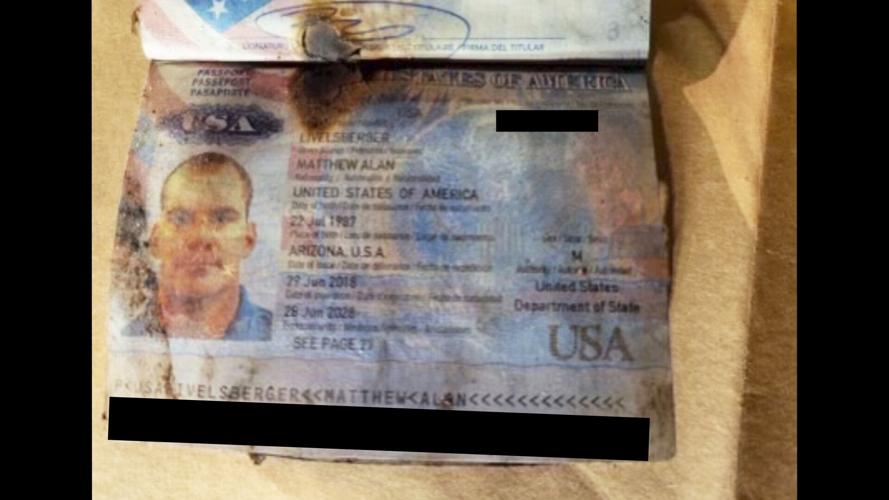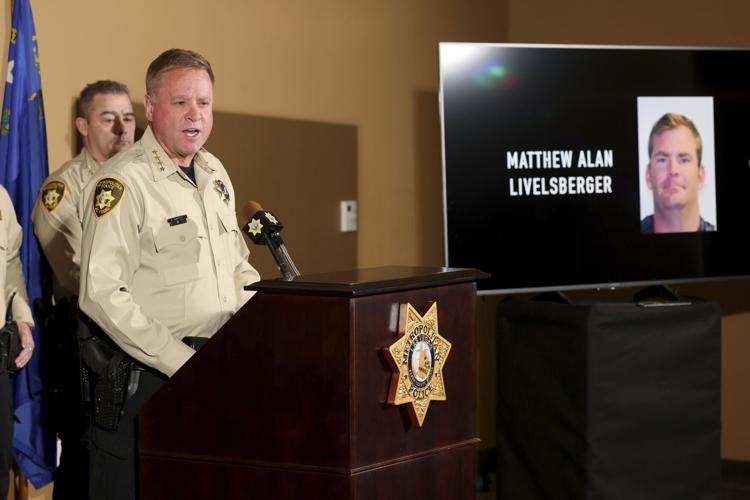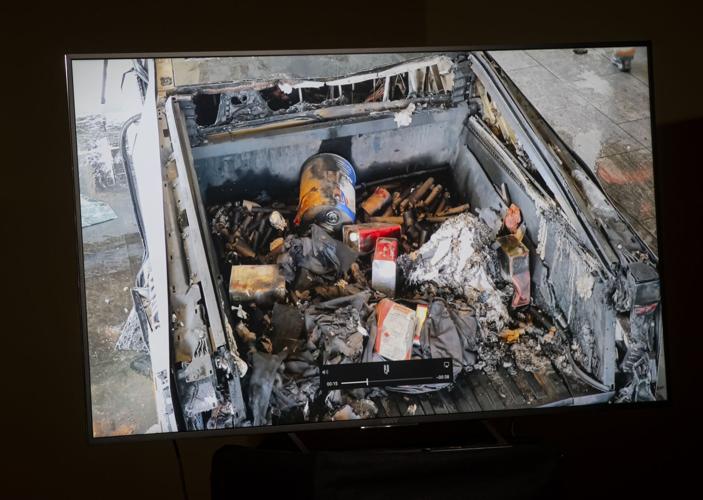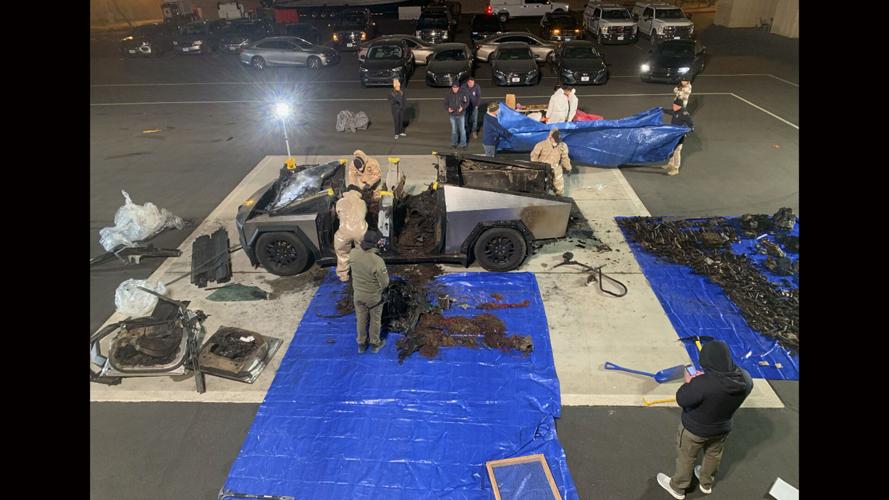A soldier who died in an explosion of a Tesla Cybertruck at the Trump hotel in Las Vegas left a note saying it was a stunt to serve as “wakeup call” for the country’s ills, investigators said Friday.

This passport belonging to Matthew Livelsberger was found inside a Tesla Cybertruck involved in an explosion Wednesday outside the Trump Hotel in Las Vegas.
Matthew Livelsberger, a 37-year-old Green Beret from Colorado Springs, Colorado, apparently harbored no ill will toward President-elect Donald Trump, Clark County sheriff’s officials said.
Livelsberger wrote in the note that he needed to “cleanse my mind” of the lives lost of people he knew and “the burden of the lives I took.”
“Although this incident is more public and more sensational than usual, it ultimately appears to be a tragic case of suicide involving a heavily decorated combat veteran who was struggling with PTSD and other issues,” FBI Special Agent In Charge Spencer Evans said at a news conference.
People are also reading…
The explosion Wednesday caused minor injuries to seven people but virtually no damage to the hotel.
“This was not a terrorist attack, it was a wakeup call. Americans only pay attention to spectacles and violence. What better way to get my point across than a stunt with fireworks and explosives,” Livelsberger wrote in a letter found by authorities who released only excerpts of it.
Investigators identified the Tesla driver — who was burned beyond recognition — as The Clark County coroner’s office said his death was a suicide caused by the gunshot wound.

Clark County Sheriff Kevin McMahill updates the media Thursday at Metropolitan Police Department headquarters in Las Vegas regarding the Tesla Cybertruck that exploded at the Trump International Hotel.
Soldier told ex-girlfriend of pain, exhaustion after Afghanistan
Pentagon officials declined to say whether Livelsberger may have suffered from mental health issues but said they turned over his medical records to police.
Livelsberger confided to a former girlfriend — who served as an Army nurse — that he faced significant pain and exhaustion that she says were key symptoms of traumatic brain injury.
Livelsberger was a five-time Bronze Star recipient, including one with a V device for valor under fire. He was very private but shared images and texts with Alicia Arritt, 39, who he met and began dating in Colorado in 2018. In them he opened up about exhaustion, pain that kept him awake at night and reliving violence from his deployment in Afghanistan.
“My life has been a personal hell for the last year,” he told Arritt during the early days of their dating, according to text messages she provided to the AP. “It’s refreshing to have such a nice person come along.”

Items in the back of the Tesla Cybertruck which exploded in front of Trump International Hotel are shown in a video during an update to media at Metropolitan Police Department headquarters Wednesday, Jan. 1, 2025, in Las Vegas. (Chase Stevens/Las Vegas Review-Journal via AP)
Arritt also served on active duty in the Army as a nurse from 2003 to 2007, deploying to the military’s massive medical complex in Germany where she helped treat many soldiers with traumatic brain injuries and blast injuries from intense ground combat in Afghanistan and Iraq.
She said the military failed to get Livelsberger the care he needed, symptoms she saw in him as early as 2018.
“He would go through periods of withdrawal, and he struggled with depression and memory loss,” Arritt said. “He said it was a blast injury. He got several concussions from that.”
Livelsberger also had a hard time with post-traumatic stress disorder and would relive some of the violence and killings he had a role in or witnessed in Afghanistan.
“I would encourage him to get therapy, and he would give me reasons that he couldn’t,” Arritt said. “There was a lot of stigma in his unit, they were, you know, big, strong, Special Forces guys there, there was no weakness allowed and mental health is weakness is what they saw.”

This undated photo, provided by the Las Vegas Police Department shows the Tesla Cybertruck involved in an explosion outside the Trump Hotel in Las Vegas. (Las Vegas Police Department via AP)
The new details came as investigators sought to determine Livelsberger’s motive, including whether he sought to make a political point with the Tesla and the hotel bearing the president-elect’s name.
Tesla CEO Elon Musk recently became a member of President-elect Donald Trump’s inner circle. Neither Trump nor Musk was in Las Vegas early Wednesday, the day of the explosion. Both attended Trump’s New Year’s Eve party at his South Florida estate.
Musk spent an estimated $250 million during the presidential campaign to support Trump, who named Musk, the world’s richest man, to co-lead a new effort to find ways to cut the government’s size and spending.

A Tesla Cybertruck pulls in to Trump International Hotel on Thursday in Las Vegas.
Investigators suspect Livelsberger may have been planning a more damaging attack but the steel-sided vehicle absorbed much of the force from the crudely built explosive.
The explosion of the truck, packed with firework mortars and camp fuel canisters, came hours after 42-year-old Shamsud-Din Bahar Jabbar rammed a truck into a crowd in New Orleans’ famed French Quarter early on New Year’s Day, killing at least 14 people before being shot to death by police. The FBI said it believes Jabbar acted alone and that incident is being investigated as a terrorist attack.
Chris Raia, FBI deputy assistant director, said Thursday that officials found “no definitive link” between the New Orleans attack and the truck explosion in Las Vegas.
7 alarming veteran mental health statistics (and tips for support)
7 alarming veteran mental health statistics (and tips for support)

Active military service lasts for a handful of years on average but can have a lifelong impact on mental health. Military veterans are more likely to deal with mental health challenges and traumatic brain injury than non-veterans, data shows. A 2014 study found that one in four veterans meet the diagnostic criteria for a mental health issue, with one in 10 struggling with multiple conditions.
Among the most commonly diagnosed conditions is post-traumatic stress disorder (PTSD), which became a recognized condition from research studies on Vietnam War veterans. According to the U.S. Department of Veteran Affairs (VA), about 7% of veterans will experience PTSD at some point in their life, compared to 6% of civilians. PTSD rates differ by service era, significantly increasing since World War II, and risk factors such as deployment, which triples the likelihood of diagnosis.
Another prevalent condition among veterans is substance use disorder (SUD), which commonly co-occurs with PTSD. The VA found that more than one in five veterans with PTSD also have SUD, and about one-third of veterans seeking treatment for SUD also have PTSD.
Although these conditions are treatable, factors like stigma, financial barriers, and VA health care system issues stop some veterans from accessing needed mental health care, data shows. The outcome can be dire: roughly 17 veterans die by suicide each day, according to a 2022 report. If you're having thoughts of harming yourself or someone else, this is a mental health emergency, and you should contact the 24/7 Suicide & Crisis Lifeline by calling or texting 988.
Charlie Health outlines some of the most alarming veteran mental health statistics, which shed light on the veteran mental health crisis. We also offered some evidence-based tips for coping with conditions commonly seen in military personnel. Whether you or a loved one have served in the military, it's important to stay informed about veteran mental health and know how and when to get needed mental health care.
1. Nearly 1 in 3 veterans from wars in Iraq and Afghanistan develop PTSD
A large study of veterans found that nearly one-third (29%) of those who served during Operation Enduring Freedom and Operation Iraqi Freedom will develop PTSD at some point in their lives. As mentioned, veteran PTSD rates vary based on many factors, including service era. According to the VA, lifetime veteran PTSD rates have increased more than eightfold since World War II, though the department notes that study methods may impact this data.
2. PTSD rates among female veterans are more than double those of male veterans
Gender is another factor that affects PTSD rates among veterans. Female veterans are more than twice as likely to experience PTSD (13%) as compared to male veterans (6%), according to the VA. The VA is still in the process of learning more about PTSD rates among transgender and non-binary veterans.
3. About 1 in 3 female veterans face sexual trauma during service
Military sexual trauma, the term used by the VA, accounts for all sexual assault and sexual harassment that happens during military service. Among female veterans seen by VA providers, rates of military sexual trauma are about one in three—considered a possible driver of high female veteran PTSD rates. About one in 50 male veterans report military sexual trauma, too. However, the department notes that this data doesn't account for veterans seeking non-VA health care.
4. About 1 in 10 veterans returning from war in Iraq and Afghanistan struggle with alcohol or drug use
PTSD is not the only mental health condition affecting military service members. Substance use disorder (SUD) is also common, affecting about one in 10 veterans returning from war in Iraq and Afghanistan, according to VA data. As mentioned, SUD also often co-occurs with PTSD among veterans (and non-veterans).
5. About 1 in 10 outpatient military clinic appointments is for depression
Research shows that 9% of all appointments at outpatient military clinics are for depression. The military setting can trigger and worsen depression, with factors like separation from loved ones, combat stress, and exposure to danger increasing the risk for both active-duty personnel and veterans.
6. Since 9/11, military suicide rates are four times higher than deaths in war operations
Death by suicide has long been a driver of veteran mortality, accounting for four times as many deaths as those in war operations since 9/11, according to a recent paper. The paper also concluded that this finding means the veteran suicide rate is outpacing the suicide rate among non-veterans for the first time since the Vietnam War.
7. The veteran suicide rate is 1.5 times higher than that of the general population
Specifically, the veteran suicide rate is 1.5 times higher than that of the general population, according to the 2023 National Veteran Suicide Prevention Annual Report. In fact, suicide is the second-leading cause of death among veterans under 45 years old, the report concluded.
3 tips for supporting veteran mental health
The conditions most commonly seen among veterans are treatable, and many veteran deaths by suicide are preventable. On a macro level, and above all, health care providers need to know the warning signs of mental health crises and increase military cultural competence. If you're a veteran or have a military family member, though, there are still things you can do to promote veteran well-being. Here are three tips for supporting veteran mental health.
1. Try meditation or yoga
Both mindfulness exercises have been shown to improve PTSD symptoms when used in conjunction with other mental health support, like therapy and medication.
2. Know the signs of a mental health crisis
Research shows that identifying and talking about suicidality can reduce the risk of suicide, which is why it's important to know the warning signs of a mental health crisis. Some common signs of a mental health crisis include:
- Expressing feelings of hopelessness or having no reason to live
- Withdrawal from friends, family, and activities
- Giving away possessions or making final arrangements
- Increased use of alcohol or drugs
- Overwhelming sadness or emotional numbness
Consider using online resources like those from the American Foundation for Suicide Prevention or talking to a mental health professional for more information.
3. Reach out for help
Stigma and lack of access keep many veterans from accessing the mental health care they need, but remember, asking for help is a sign of bravery. Most VA clinics have resources and mental health care referrals, and there are many options online.
This story was produced by Charlie Health and reviewed and distributed by Stacker Media.

Veteran homelessness is on the rise despite government efforts—here's how it happens
Veteran homelessness is on the rise despite government efforts—here's how it happens

Homelessness reached record levels in 2023, as rents and home prices continued to rise in most of the U.S. One group was particularly impacted: people who have served in the U.S. military.
"This time last year, we knew the nation was facing a deadly public health crisis," Jeff Olivet, executive director of the U.S. Interagency Council on Homelessness, said in a statement about the 2023 numbers. He said the latest homelessness estimates from the Department of Housing and Urban Development "confirms the depth of the crisis."
At least 35,000 veterans were experiencing homelessness in 2023, according to HUD. While that's about half of what it was in 2009—when the organization began collecting data—things have plateaued in recent years despite active efforts to get that number to zero.
Although they make up just 6.6% of the total homeless population, veterans are more likely to be at risk of homelessness than Americans overall. Of every 10,000 Americans, 20 were experiencing homelessness. Of veterans living in the United States, that number jumps to 22, HUD data shows.
Complicated by bureaucracy, family dynamics, and prejudice, the path from serving in the military to homelessness is a long one. According to a 2022 study by Yale School of Medicine researchers, homelessness typically occurs within four years of leaving the military, as veterans must contend with the harsh reality of finding a job in a world where employers struggle to see how skills on the battlefield transfer to a corporate environment.
These days, veterans also deal with historically high rent and home prices, which causes many to rely on family generosity while figuring out a game plan.
Stacker examined academic studies, analyzed government data, and spoke with members of the Biden administration, experts, and former members of the armed forces to see the struggles members of the military face when leaving the armed forces.

Veterans struggle to find a path forward

The Department of Veterans Affairs offers transition assistance to the roughly 250,000 service members who leave each year. However, those programs can be burdensome and complex to navigate, especially for those who don't have a plan for post-military life.
Only a small portion of veterans have jobs lined up when they leave, according to 2019 Pew Research. Many also choose to live with relatives until they get on their feet, which can be longer than anticipated. Some former service members are unsure what kind of career they'd like to pursue and may have to get further education or training, Carl Castro, director of the Military and Veteran Programs at the Suzanne Dworak-Peck School of Social Work at the University of Southern California, told Stacker.
"It takes years for that kind of transition," Castro said.
Many have trouble finding a job after leaving the service, even if they are qualified. Some employers carry misconceptions about those who have served. A 2020 analysis from the journal Human Resource Management Review found that some veterans face hiring discrimination due to negative stereotypes that lead hiring managers to write them off as a poor culture fit.
Underemployment, or working low-wage jobs below their skill level, is also an issue. While the unemployment rate for veterans was 3% in March 2024, a study released by Penn State at the end of 2023 found three years after leaving the service, 61% of veterans said they were underemployed because of perceived skill mismatches.
This phenomenon can have long-term economic effects, and eventually, that frustration can boil over, strain relationships, and potentially lead to housing instability.
Working, especially a low-wage job, is not protection against homelessness. A 2021 study from the University of Chicago found half of people living in homeless shelters and 2 in 5 unsheltered people were employed, full or part-time.
Some veterans struggle to find homes in their budget

High rents make it difficult to save up, even when applying for a VA loan—a mortgage backed by the Department of Veterans Affairs that typically has more favorable terms.
While the VA does not require a downpayment, some lenders, who ultimately provide the loan, do. They're not entirely risk-free either, and veterans can still lose their homes if they are unable to keep up with their mortgages.
In November 2023, the VA put a six-month pause on foreclosures when an NPR investigation found thousands of veterans were in danger of losing their homes after a COVID forbearance program ended.
Biden officials pointed to high rents and the end of COVID-era housing restrictions like eviction moratoriums to explain the spike in Americans experiencing homelessness. In the last year, homelessness rose 12%—to more than 650,000 people—the highest level since data began being collected in 2007.
Overall, more than half of people experiencing homelessness in 2023 live in states with high living costs. Most were in California, followed by New York and Florida. Western states, including Montana and Utah, experienced massive population growth during the pandemic, becoming hubs for remote workers who drove home prices and rents even further.
Vets with mental health issues most at risk for homelessness

For veterans, housing costs certainly play a role, but those who leave the military also face systemic barriers.
"It's worrying there are people that continue to fall through the cracks," said Jeanette Yih Harvie, a research associate at Syracuse University's D'Aniello Institute for Veterans and Military Families.
Just under a quarter of adults experiencing homelessness have a severe mental illness, according to 2022 HUD survey data. They are also likely to have chronic illnesses but are unable to maintain preventative care, which only exacerbates these problems.
Veterans facing homelessness are more likely to have experienced trauma, either before or after joining the military, according to Yale researchers who analyzed the 2019-2020 National Health and Resilience in Veterans Study. Childhood trauma was among the most significant commonalities among vets who become homeless. Substance use disorder is also widespread and can indicate an undiagnosed mental illness.
Racial and ethnic disparities are at play, too. A 2023 study in the Journal of Psychiatric Research showed that Hispanic and Black veterans were more likely to screen positive for PTSD, and Hispanic veterans were more likely to report having suicidal ideation.
Overall, access to mental health care has improved in the last decade or so. In December 2023, the VA announced it would open nine additional counseling centers. However, the stigma of getting help remains, especially after years of being conditioned to be self-reliant and pull oneself up by their bootstraps.
That help, in the form of public policy, is slowly working to catch up to the need.
In 2023, the Biden administration invested millions into research programs and studies on suicide prevention by the VA office in addition to a proposed $16 billion to improve quality and lower-cost mental health care services for veterans. And, in February of this year, HUD and the VA announced they would give up to $14 million in vouchers to public housing agencies for veterans experiencing homelessness. The program would also offer case management and other services.
Still, with a culture that pushes people to keep going, it can be challenging for servicemembers to take advantage of these opportunities, Harvie said. "When you've been doing that for the last 15 or 20 years, it's difficult to stop and say, 'I'm the person that needs help.'"
Story editing by Kelly Glass. Copy editing by Kristen Wegrzyn.















